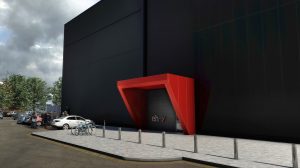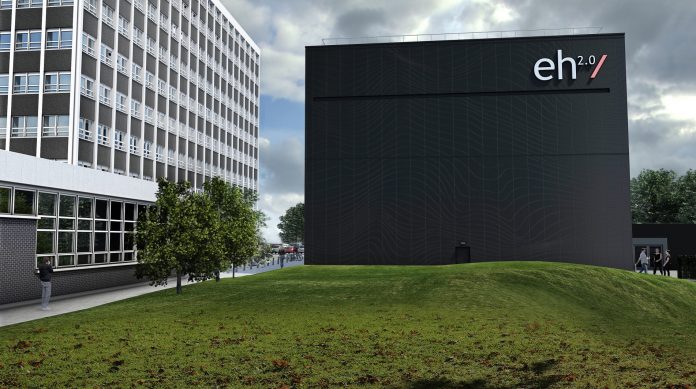Professor Will Swan and Dr Richard Fitton discuss the University of Salford’s Energy House 2.0, a state-of-the-art research facility that will test new technology to help speed up the development of better, more reliable products for the built environment
The University of Salford has recently announced the appointment of Bowmer & Kirkland as the main contractor for the delivery of the groundbreaking Energy House 2.0 research facility. Part funded by the European Regional Development Fund and the former HEFCE’s Catalyst fund, the facility represents a major development for the UK in the delivery of a future, low energy built environment.
This £16m research project is the product of four years of work by Salford’s Energy House Laboratories team, with support from the Greater Manchester Combined Authority and industry, and it will look to open its doors in 2021.
The building will have two large environmental chambers, covering weather conditions for more than 95% of the world’s population. It will allow companies ranging from constructors, to energy companies, to digital start-ups to innovate their products and services in a number of rapidly developing global markets.
The University of Salford has developed a unique approach to working with industry in the energy and buildings sector, starting with the Salford Energy House, which was developed in 2011. The Salford Energy House is a Victorian end terrace housed inside a climate-controlled lab, and represented a world-first when it was first launched.
The concept of testing energy efficiency products under controlled conditions was new to the industry, but they quickly understood that tests that were repeatable and highly monitored could tell them things about their products in a matter of weeks when compared to the difficulties of conducting field trials in occupied properties.
Major companies and groups such as Saint Gobain, Stelrad, Veissmann and BEAMA have worked with the team at the University of Salford to undertake innovative research at the facility.
The Salford Energy House has also attracted global interest from the media, with the BBC, Sky News, MSNBC and Reuters all reporting from the facility.
Over the past eight years, the Salford team have expanded their skillset from looking at product and system efficiency to engaging with the “smart” agenda. In 2018, having worked with smart meters for more than three years, they opened the Smart Meters Smart Homes Laboratory, providing a facility where the interaction between smart meters, energy storage, car charging and smart homes technology can all be explored.
Energy House 2.0 brings these strands of work together. It provides an internationally leading research facility, specifically focused on working to address the challenges of the UK Industrial Strategy. It has been designed to address a number of emerging challenges in both the energy and construction sectors.
In terms of energy, the UK is undergoing a major transition. A number of trends can be seen that will affect UK consumers and businesses in the next few years.
The first major issue is the electrification of heating and transport; the end of new gas connections in 2025 and the drive towards electric vehicles means we will have different demands on our energy infrastructure and change the way electricity is consumed. The second major issue will be the growth of renewables and storage, which is rapidly developing into a major financial proposition for the domestic sector.
Additionally, the growth of “alternative energy vectors”, such as hydrogen and heat networks, present new challenges for innovators.
Binding this all together is the major trend towards smart energy consumption. The UK’s smart meter infrastructure represents a major step in making the delivery of new energy services possible. Demand-side response, peer-to-peer trading and aggregation services are all emerging as possibilities for UK consumers.
In these models, the consumer is no longer a passive recipient of energy, but they can generate, trade and store energy to generate income.
The recent HAVEN project undertaken by the University of Salford, Good Energy, Upside Energy and Honda, funded by Innovate UK, estimated these types of income streams might be worth up to £500 per annum for some domestic consumers.
From the perspective of the construction industry, the major trend, as highlighted in Mark Farmer’s Modernise or Die, is the move towards offsite construction, particularly in the domestic market, where issues of skills and product quality have become a major issue.

This requirement to innovate rapidly requires us to be able to make good decisions and to do this we need good data. We have to understand what works technically, financially and from a user perspective.
A change of heating system can be challenging for a consumer, while fundamentally changing how they buy and use energy can be even more daunting. The role of Energy House 2.0 is to find a way to bring innovators together to shape the future of housing and energy in a way that consumers will understand.
Demonstrating new technology working at scale in a realistic context, and backing this up with robust and detailed data, is a major step in this direction. Being able to do this rapidly under controlled conditions means that we can shorten development cycles and get better, more reliable products and services to the market more quickly.
While innovation sits at the heart of what Energy House 2.0 does, it is also backed up by a strong understanding of the research, as the team looks for new ways of measuring and evaluating buildings and systems.
One of the major changes in Energy House 2.0 is the focus on the occupant. The facility has been designed with a view to allowing studies with occupants to be undertaken safely. This is an essential part of the story of our energy future; we must place people at the centre of it. If we want our energy transition to be successful, we need to understand what the risks are and what protections and support we might need to put in place for people. This might be about ensuring new products are better designed with occupants in mind, to understanding how occupants might make the most of new energy assets such as renewables or batteries.
Energy House 2.0 is a major investment and in 2021 it will support the industry in developing major potential opportunities in delivering clean growth for the UK economy. The aspiration for the facility is that it becomes a point where industry, academia, government and the third sector can come together to address some of the major global challenges around energy consumption and the delivery of the future built environment.
Professor Will Swan
Associate Dean Enterprise
University of Salford School of the Built Environment
Tel: +44 (0)161 295 2585
Dr Richard Fitton
Lecturer in Energy Efficiency
University of Salford School of the Built Environment
Tel: +44 (0)161 295 6804
www.salford.ac.uk/built-environment
Twitter: Sobe_salford

















